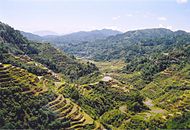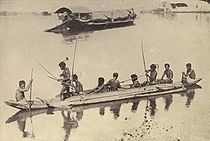- Cultural achievements of pre-colonial Philippines
-
History of Philippines 
This article is part of a seriesEarly History (pre-900) Callao Man Arrival of the Negritos Austronesian expansion Angono Petroglyphs Classical Epoch (900-1521) Ma-i Dynasty of Tondo Confederation of Madya-as Kingdom of Maynila Kingdom of Namayan Rajahnate of Butuan Rajahnate of Cebu Sultanate of Maguindanao Sultanate of Sulu Spanish Era (1521–1898) Dutch Invasions (1600–1647) British Rule (1762–1764) Spanish East Indies Philippine Revolution (1896–1898) Katipunan American Period (1898–1946) First Republic Philippine–American War Commonwealth Japanese Occupation (1942–1944) Second Republic Since Independence (1946–present) Third Republic Marcos Regime Fifth Republic Timeline Military history Communications history Demographic history Transportation history
Philippines Portal
v · prehistory and early history of the Philippines archipelago and its inhabitants, which are the indigenous forebears of today's Filipino people.Contents
Agriculture
 The Banaue Rice Terraces, they are part of the Rice Terraces of the Philippine Cordilleras, ancient sprawling man-made structures from 2,000 to 6,000 years old, which are a UNESCO World Heritage Site.
The Banaue Rice Terraces, they are part of the Rice Terraces of the Philippine Cordilleras, ancient sprawling man-made structures from 2,000 to 6,000 years old, which are a UNESCO World Heritage Site.
Early Filipinos were good agriculturists. A report during the time of Miguel López de Legazpi noted of the great abundance of rice, fowls, wine as well as great numbers of carabaos, deer, wild boar and goats in Luzon. In addition, there were also great quantities of cotton and colored clothes, wax, honey and date palms produced by the natives. In the Visayas, according to another early report, rice, cotton, swine, fowls, wax and honey abound. Leyte was said to produce two rice crops a year, and Pedro Chirino commented on the great rice and cotton harvests that were sufficient to feed and cloth the people
Duck culture was also practiced by the natives, particularly those around Pateros and Taguig City. This resembled the Chinese methods of artificial incubation of eggs and the knowledge of every phase of a duck's life. This tradition is carried on until modern times.[1]
The Ifugaos of the mountainous region of the Cordilleras built irrigations, dams and hydraulic works and the famous Banaue Rice Terraces as a way for assisting in growing crops around 1000 BC.[1]
Art of War
Further information: Filipino martial artsHigh quality metal casting, artillery, and other metal works had been traditions throughout the ancient Philippines. The metal smith, or panday piray of Pampanga was skilled at making weapons, and many individuals with the surnames Viray and Piray are said to be descendants of people who once members of the guild of smiths who followed the tradition of the panday pira.[1]
Early Filipinos used small arquebuses, or portable cannons made up of bronze. Larger cannons, on the other hand, were made of iron and resembling culverins provided heavier firepower. The iron cannon at Rajah Sulaiman III's house was about 17 feet long and was made from clay and wax moulds.[1]
Guns were also locally manufactured and used by the natives. The most fearsome among these native guns was the lantaka, or swivel gun, which allowed the gunner to quickly track a moving target.[1] Some of the weaponry used by the natives was quite unusual. For instance, one weapon was the prototype of the modern-day yo-yo, and it returned to is owner after being flung at an opponent.
Swords were also part of the native weaponry. Making of swords involved elaborate rituals that were based mainly on the auspicious conjunctions of planets. The passage of the sword from the maker entailed a mystical ceremony that was coupled with superstitious beliefs.[1] The lowlanders of Luzon no longer use of the bararao, while the Moros and animists of the South still continue the tradition of making kampilan and kris.[1]
In addition to weaponry, the early Filipinos made good armor for use in the battlefield and built strong fortress called kota or moog to protect their communities. The Moros, in particular, had armor that covered the entire body from the top of the head to the toes. The Igorots built forts made of stone walls that averaged several meters in width and about two to three times the width in height around 2000 BC.[1][2]
Education and writing
 Laguna Copperplate Inscription (circa 900 AD), a thin copperplate document measuring less than 8x12 inches in size, shows heavy Hindu-Malayan cultural influences present in the Philippines during the 10th Century.
Laguna Copperplate Inscription (circa 900 AD), a thin copperplate document measuring less than 8x12 inches in size, shows heavy Hindu-Malayan cultural influences present in the Philippines during the 10th Century. See also: Ancient Philippine scripts and Enrique of Malacca
See also: Ancient Philippine scripts and Enrique of MalaccaEarly Filipinos devised and used their own system of writings from 300 BC, which derived from the Brahmic family of scripts of Ancient India. Baybayin became the most widespread of these derived scripts by the 11th century AD.
Early chroniclers, who came during the first Spanish expeditions to the islands, noted the proficiency of some of the natives, especially the chieftain and local kings, in Spanish, Latin and several other languages.[3][4]
Maritime culture and aquaculture
 Native boats and outriggers as depicted in The history and conquest of the Philippines and our other island possessions; embracing our war with the Filipinos by Alden March, published in 1899. Caption (cropped out) read: "Boats of the upper type were used to land the U.S. troops at Manila. One of those in which the Astor Battery landed sank in the surf just before reaching shore. The natives carried the men ashore on their shoulders. The lower boat is a fisherman's craft used by the Negritos, who shoot fish in the clear water with bows and arrows."
Native boats and outriggers as depicted in The history and conquest of the Philippines and our other island possessions; embracing our war with the Filipinos by Alden March, published in 1899. Caption (cropped out) read: "Boats of the upper type were used to land the U.S. troops at Manila. One of those in which the Astor Battery landed sank in the surf just before reaching shore. The natives carried the men ashore on their shoulders. The lower boat is a fisherman's craft used by the Negritos, who shoot fish in the clear water with bows and arrows."
Early Filipinos, being descendants of the balangay-borne Austronesian migrants from mainland China,[5] were known for their navigational skills. Some of them used compass similar to those used among maritime communities of Borneo and traders of China, although most had no need for such devices. In modern times, some fishermen and traders in the Visayas, Mindanao, Sulu and Palawan can still navigate long distances over open water without the use of modern navigational instruments.[1] Philippine ships, such as the karakao or korkoa were of excellent quality and some of theme were used by the Spaniards in expeditions against rebellious tribes and Dutch and British forces. Some of the larger rowed vessels held up to a hundred rowers on each side besides a contingent of armed troops.[3] Generally, the larger vessels held at least one lantaka at the front of the vessel or another one placed at the stern.[1] Philippine sailing ships called praos had double sails that seemed to rise well over a hundred feet from the surface of the water. Despite their large size, these ships had double outriggers. Some of the larger sailing ships, however, did not have outriggers.
Communities of ancient Philippines were active in international trade, and they used the ocean as natural highways.[3] Early Filipinos were engaged in long-range trading with their Asian neighbors as far as west as Maldives and as far as north as Japan.[1] Some historians even proposed that they also had regular contacts with the people of Western Micronesia because it was the only area in the Oceania that had rice crops, tuba (fermented coconut sap), and tradition of betel nut chewing when the first Europeans arrived there. The uncanny resemblance of complex body tattoos among the Visayans and those of Borneo also proved some interesting connection between Borneo and ancient Philippines.[1] Magellan's chronicler, Antonio Pigafetta, mentioned that merchants and ambassadors from all surrounding areas cameto pay tribute to the king of Sugbu (Cebu) for the purpose of trade. While Magellan's crew were with the king, a representative from Siam was paying tribute to the king.[1] Miguel López de Legazpi also wrote how merchants from Luzon and Mindoro had come to Cebu for trade, and he also mentioned how the Chinese merchants regularly came to Luzon for the same purpose.[1] The Visayan Islands had earlier encounter with the Greek traders in 21 AD. Its people enjoyed extensive trade contacts with other cultures. Arabs, Indians, Vietnamese, Thais, Cambodians, Malays and Indonesians as trader or immigrants.[6]
Aside from trade relations, the natives were also involved in aquaculture and fishing. The natives make use of the salambao, which is a type of raft that utilizes a large fishing net which is lowered into the water via a type of lever made of two criss-crossed poles. Night fishing was accomplished with the help of candles made from a particular type of resin similar to the copal of Mexico. Use of safe pens for incubation and protection of the small fry from predators was also observed, and this method astonished the Spaniards at that time.[1] During fishing, large mesh nets were also used by the natives to protect the young and ensure future good catches.
Mining and jewelry making
Mining in the Philippines began around 1000 BC. The early Filipinos worked various mines of gold, silver, copper and iron. Jewels, gold ingots, chains, calombigas and earrings were handed down from antiquity and inherited from their ancestors. Gold dagger handles, gold dishes, tooth plating, and huge gold ornamets were also used.[1] In Laszlo Legeza's "Tantric elements in pre-Hispanic Philippines Gold Art", he mentioned that gold jewelry of Philippine origin was found in Ancient Egypt.[1] According to Antonio Pigafetta, the people of Mindoro possessed great skill in mixing gold with other metals and gave it a natural and perfect appearance that could deceive even the best of silversmiths.[1] The natives were also known for the jewelries made of other precious stones such as carnelian, agate and pearl. Some outstanding examples of Philippine jewelry included necklaces, belts, armlets and rings placed around the waist.
Pottery
The ancient Philippines had a very rich tradition of pottery as verified by the finds at Ayub Cave in South Cotabato and other parts of the islands. Japanese texts mentioned trading expeditions to the island of Rusun (Luzon) for the highly-prized Rusun and Namban jars occurred. Japanese texts were very specific about these jars being made in Luzon. The Tokiko, for example, calls the Rusun and Namban jars, Ru-sun tsukuru or Lu-sung ch'i (in Chinese), which means simply "made in Luzon." [1] These Rusun jars, which had rokuru (wheel mark), were said to be more precious than gold because of its ability to act as tea canisters and enhance the fermentation process.[1]
References
- ^ a b c d e f g h i j k l m n o p q r s t Ancient Philippine Civilization. Accessed September 04, 2008.[broken citation]
- ^ Ancient and Pre-Spanis Era of the Philippines. Accessed September 04, 2008.
- ^ a b c From the mountains to the seas. Mallari, Perry Gil S. The Manila Times Internet Edition. January 18, 2009.
- ^ Bergreen, Laurence.Over The Edge of The World: Magellan’s Terrifying Circumnavigation of the Globe. New York. 2003.
- ^ The Austronesian People. Accessed September 4, 2008.
- ^ Cebu, a Port City in Prehistoric and in Present Times. Accessed September 05, 2008.
External links
- Ancient Philippine Civilization
- Austronesian migration waves and expansion in the Asia-Pacific
- Burial coffins and Grave furnitures
- The Philippines: Then and Now[broken citation]
- Pre-historic Neolithic Iron Age Culture
- Timeline of the History of the Philippines: Prehistoric times
Categories:
Wikimedia Foundation. 2010.
Look at other dictionaries:
Philippines — Philippine redirects here. For a town in the Netherlands, see Philippine, Netherlands. Republic of the Philippines Republika ng Pilipinas … Wikipedia
Cebuano literature — refers to the literary works written in Cebuano, a language widely spoken in the Philippines. The term is most often extended to cover the oral literary forms in pre Spanish Philippines.While the majority of Cebuano writers are based in the… … Wikipedia
education — /ej oo kay sheuhn/, n. 1. the act or process of imparting or acquiring general knowledge, developing the powers of reasoning and judgment, and generally of preparing oneself or others intellectually for mature life. 2. the act or process of… … Universalium
United States — a republic in the N Western Hemisphere comprising 48 conterminous states, the District of Columbia, and Alaska in North America, and Hawaii in the N Pacific. 267,954,767; conterminous United States, 3,022,387 sq. mi. (7,827,982 sq. km); with… … Universalium
Historical powers — include great powers, nations, or empires in history. The term Great power represent the most important world powers. In a modern context, recognised great powers came about first in Europe during the post Napoleonic era.[1] The formalization of… … Wikipedia
Spain — /spayn/, n. a kingdom in SW Europe. Including the Balearic and Canary islands, 39,244,195; 194,988 sq. mi. (505,019 sq. km). Cap.: Madrid. Spanish, España. * * * Spain Introduction Spain Background: Spain s powerful world empire of the 16th and… … Universalium
china — /chuy neuh/, n. 1. a translucent ceramic material, biscuit fired at a high temperature, its glaze fired at a low temperature. 2. any porcelain ware. 3. plates, cups, saucers, etc., collectively. 4. figurines made of porcelain or ceramic material … Universalium
China — /chuy neuh/, n. 1. People s Republic of, a country in E Asia. 1,221,591,778; 3,691,502 sq. mi. (9,560,990 sq. km). Cap.: Beijing. 2. Republic of. Also called Nationalist China. a republic consisting mainly of the island of Taiwan off the SE coast … Universalium
Australia — /aw strayl yeuh/, n. 1. a continent SE of Asia, between the Indian and the Pacific oceans. 18,438,824; 2,948,366 sq. mi. (7,636,270 sq. km). 2. Commonwealth of, a member of the Commonwealth of Nations, consisting of the federated states and… … Universalium
Christianity — /kris chee an i tee/, n., pl. Christianities. 1. the Christian religion, including the Catholic, Protestant, and Eastern Orthodox churches. 2. Christian beliefs or practices; Christian quality or character: Christianity mixed with pagan elements; … Universalium
18+© Academic, 2000-2024- Contact us: Technical Support, Advertising
Dictionaries export, created on PHP, Joomla, Drupal, WordPress, MODx.Share the article and excerpts
Cultural achievements of pre-colonial Philippines
- Cultural achievements of pre-colonial Philippines
-
History of Philippines 
This article is part of a seriesEarly History (pre-900) Callao Man Arrival of the Negritos Austronesian expansion Angono Petroglyphs Classical Epoch (900-1521) Ma-i Dynasty of Tondo Confederation of Madya-as Kingdom of Maynila Kingdom of Namayan Rajahnate of Butuan Rajahnate of Cebu Sultanate of Maguindanao Sultanate of Sulu Spanish Era (1521–1898) Dutch Invasions (1600–1647) British Rule (1762–1764) Spanish East Indies Philippine Revolution (1896–1898) Katipunan American Period (1898–1946) First Republic Philippine–American War Commonwealth Japanese Occupation (1942–1944) Second Republic Since Independence (1946–present) Third Republic Marcos Regime Fifth Republic Timeline Military history Communications history Demographic history Transportation history
Philippines Portal
